
Railroad tie
Encyclopedia
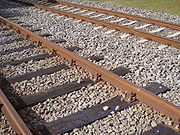
Track ballast
Track ballast forms the trackbed upon which railway sleepers or railroad ties are laid. It is packed between, below, and around the ties. It is used to facilitate drainage of water, to distribute the load from the railroad ties, and also to keep down vegetation that might interfere with the track...
and subgrade
Subgrade
In transport engineering, subgrade is the native material underneath a constructed road, pavement or railway track. It is also called formation level.The term can also refer to imported material that has been used to build an embankment....
, and to hold the rails upright and to the correct gauge
Rail gauge
Track gauge or rail gauge is the distance between the inner sides of the heads of the two load bearing rails that make up a single railway line. Sixty percent of the world's railways use a standard gauge of . Wider gauges are called broad gauge; smaller gauges, narrow gauge. Break-of-gauge refers...
.
Traditionally, ties have been made of wood
Wood
Wood is a hard, fibrous tissue found in many trees. It has been used for hundreds of thousands of years for both fuel and as a construction material. It is an organic material, a natural composite of cellulose fibers embedded in a matrix of lignin which resists compression...
, but pre-stressed concrete is now widely used especially in Europe and Asia. Steel
Steel
Steel is an alloy that consists mostly of iron and has a carbon content between 0.2% and 2.1% by weight, depending on the grade. Carbon is the most common alloying material for iron, but various other alloying elements are used, such as manganese, chromium, vanadium, and tungsten...
ties are widely used on secondary lines in the UK and plastic
Plastic
A plastic material is any of a wide range of synthetic or semi-synthetic organic solids used in the manufacture of industrial products. Plastics are typically polymers of high molecular mass, and may contain other substances to improve performance and/or reduce production costs...
composite ties are currently used as well, although far less than wood or concrete ties. As of January 2008, the approximate market share, in North America, for traditional and wood ties was 91.5%, whereas the approximate combined market share for (all) concrete, steel, azobé
Lophira alata
Lophira alata is a species of plant in the Ochnaceae family. It is found in Cameroon, the Republic of the Congo, the Democratic Republic of the Congo, Ivory Coast, Equatorial Guinea, Gabon, Ghana, Liberia, Nigeria, Sierra Leone, Sudan, and Uganda. Its natural habitat is subtropical or tropical...
(red ironwood) and plastic composite ties was 8.5%.
Ties are normally laid on top of track ballast, which supports and holds them in place, and provides drainage and resilience. Heavy crushed stone
Rock (geology)
In geology, rock or stone is a naturally occurring solid aggregate of minerals and/or mineraloids.The Earth's outer solid layer, the lithosphere, is made of rock. In general rocks are of three types, namely, igneous, sedimentary, and metamorphic...
is the normal material for the ballast, but on lines with lower speeds and axle-weights, sand
Sand
Sand is a naturally occurring granular material composed of finely divided rock and mineral particles.The composition of sand is highly variable, depending on the local rock sources and conditions, but the most common constituent of sand in inland continental settings and non-tropical coastal...
, gravel
Gravel
Gravel is composed of unconsolidated rock fragments that have a general particle size range and include size classes from granule- to boulder-sized fragments. Gravel can be sub-categorized into granule and cobble...
, and even ash from the fires of coal-fired steam locomotives have been used.
Up to 3000 ties are used per mile of railroad track in the USA. On main lines in the UK, sleepers are laid at up to 2640 per mile (30 per 60ft rail). Rails may be fastened to the tie by a railroad spike (especially in the USA) or by means of iron/steel baseplates as generally used in Europe. Baseplates are screwed to the sleeper and the rail secured to the baseplate by a proprietary fastening system such as a Vossloh
Vossloh
Vossloh AG is a German transport technology manufacturer based in the Westphalian town of Werdohl. The group has 4,700 employees , and generated sales of €1.2 billion, of which approximately 60% came from the rail infrastructure division, and the remainder from the motive power and components...
or Pandrol
Pandrol
Pandrol is a British company, which manufactures clips used on rail tracks.- Overview :The was patented in 1957 by a Norwegian railways engineer, Per Pande Rolfsen. Nowadays it is common worldwide. Pandrol has manufacturing plants in 12 countries and 82 markets. Over 240 railway systems in 91...
fastening.
Stone block
The type of sleeper used on the predecessors of the first true railway (Liverpool and Manchester RailwayLiverpool and Manchester Railway
The Liverpool and Manchester Railway was the world's first inter-city passenger railway in which all the trains were timetabled and were hauled for most of the distance solely by steam locomotives. The line opened on 15 September 1830 and ran between the cities of Liverpool and Manchester in North...
) consisted of a pair of stone blocks laid into the ground, with the chairs holding the rails fixed to those blocks. One advantage of this method of construction was that it allowed horses to tread the middle path without the risk of tripping. In railway use with ever heavier locomotives, it was found that it was hard to maintain the correct gauge
Rail gauge
Track gauge or rail gauge is the distance between the inner sides of the heads of the two load bearing rails that make up a single railway line. Sixty percent of the world's railways use a standard gauge of . Wider gauges are called broad gauge; smaller gauges, narrow gauge. Break-of-gauge refers...
. The stone blocks were in any case unsuitable on soft ground, where timber sleepers had to be used.
Wooden
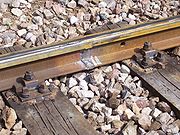
Softwood
The term softwood is used to describe wood from trees that are known as gymnosperms.Conifers are an example. It may also be used to describe trees, which tend to be evergreen, notable exceptions being bald cypress and the larches....
and hardwood
Hardwood
Hardwood is wood from angiosperm trees . It may also be used for those trees themselves: these are usually broad-leaved; in temperate and boreal latitudes they are mostly deciduous, but in tropics and subtropics mostly evergreen.Hardwood contrasts with softwood...
s timbers are used as ties, oak
Oak
An oak is a tree or shrub in the genus Quercus , of which about 600 species exist. "Oak" may also appear in the names of species in related genera, notably Lithocarpus...
, jarrah
Jarrah
Eucalyptus marginata is one of the most common species of Eucalyptus tree in the southwest of Western Australia. The tree and the wood are usually referred to by the Aboriginal name Jarrah...
and karri
Karri
Eucalyptus diversicolor, commonly known as the Karri, is a eucalypt which is native to the wetter regions of south west of Western Australia.-Description:...
being popular hardwoods, although increasingly difficult to obtain, especially from sustainable sources. Some lines use softwood
Softwood
The term softwood is used to describe wood from trees that are known as gymnosperms.Conifers are an example. It may also be used to describe trees, which tend to be evergreen, notable exceptions being bald cypress and the larches....
s, including Douglas fir; while they have the advantage of accepting treatment more readily, they are more susceptible to wear but are cheaper, lighter (and therefore easier to handle) and more readily available. Softwood is treated, historically using creosote
Creosote
Creosote is the portion of chemical products obtained by the distillation of a tar that remains heavier than water, notably useful for its anti-septic and preservative properties...
, but nowadays with other less-toxic preservatives
Wood preservation
All measures that are taken to ensure a long life of wood fall under the definition wood preservation . Apart from structural wood preservation measures, there are a number of different preservatives and processes that can extend the life of wood, timber, wood structures or engineered wood...
to improve resistance to insect infestation and rot. New boron based wood preserving technology is being employed by major US railroads in a dual treatment process in order to extend the life of wood ties in wet areas. Some timbers (such as sal, mora
Mora (plant)
Mora is a genus of large trees in the subfamily Caesalpinioideae of the legume family Fabaceae. There are seven species, all native to lowland rainforests in northern South America, southern Central America and the southern Caribbean islands....
or azobé) are durable enough that they can be used untreated.
Problems with wood ties include rot, splitting, insect infestation, plate-cutting (known as chair shuffle in the UK)(abrasive damage to the tie caused by lateral motion of the tie plate) and spike-pull (where the spike is gradually worked out and loosened from the tie). For more information on wood ties the Railway Tie Association maintains a comprehensive website devoted to wood tie research and statistics.
Concrete

World War II
World War II, or the Second World War , was a global conflict lasting from 1939 to 1945, involving most of the world's nations—including all of the great powers—eventually forming two opposing military alliances: the Allies and the Axis...
following advances in the design, quality and production of pre-stressed concrete. Concrete ties were cheaper and easier to obtain than timber and better able to carry higher axle-weights and sustain higher speeds. Their greater weight ensures improved retention of track geometry especially when installed with continuous-welded rail. Concrete sleepers have a longer service life and require less maintenance than timber due to their greater weight which helps them remain in the correct position for longer. Concrete sleepers need to be installed on a well-prepared subgrade with an adequate depth on free-draining ballast to perform fully.
In 1877, M. Monnier, a French gardener, suggested that concrete could be used for making ties for railway track. Monnier designed a tie and obtained a patent for it, but it was not successful. Designs were further developed and the railways of Austria and Italy used the first concrete ties around the turn of the 20th century. This was closely followed by other European railways.
Major progress could not be achieved until World War II
World War II
World War II, or the Second World War , was a global conflict lasting from 1939 to 1945, involving most of the world's nations—including all of the great powers—eventually forming two opposing military alliances: the Allies and the Axis...
, when the timbers used for ties were extremely scarce due competition from other uses such as in mines. Following research carried out on French and other European railways, the modern pre-stressed concrete tie was developed. Heavier rail sections and long welded rails were also being installed, requiring higher-quality ties. These conditions spurred the development of concrete ties in France, Germany and Britain, where the technology was perfected. On the highest categories of line in the UK (those with the highest speeds and tonnages) pre-stressed concrete sleepers are the only ones permitted by Network Rail
Network Rail
Network Rail is the government-created owner and operator of most of the rail infrastructure in Great Britain .; it is not responsible for railway infrastructure in Northern Ireland...
standards.
Most European railways also now use concrete bearers in switches and crossing layouts due to the longer life and lower cost of concrete bearers compared to timber, which is increasingly difficult and expensive to source in sufficient quantities and quality.
On November 8, 2011, the U.S. Federal Railroad Administration put into effect new regulations on concrete ties, with notices published by the FRA in the April 1 and September 9, 2011 U. S. Federal Register. The FRA notices say that the need for the new rules was shown by the derailment of an Amtrak train near Home Valley, Washington on April 3, 2005, which according to the U.S. National Transportation Safety Board was caused in part by excessive concrete tie abrasion. To be counted as a good tie under FRA regulation 213.109(d)(4), a concrete ties shall not be deteriorated or abraded under the rail to a depth of one-half inch or more. Limits on other types of concrete tie deterioration are also given.
Steel
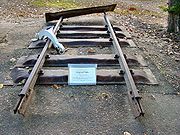
Historically, steel ties (sleepers) have suffered from poor design and increased traffic loads over their normally long service life. These aged and often obsolete designs limited load and speed capacity but can still, to this day, be found in many locations globally and performing adequately despite decades of service. There are great numbers of steel ties with over 50 years of service and in some cases they can and have been rehabilitated and continue to perform well. Steel ties were also used in specialty situations, such as the Hejaz Railway in the Arabian Peninsula, which had an ongoing problem with Bedouins who would steal wooden ties for campfires.
Modern steel ties handle heavy loads, have a proven record of performance in signalized track, and handle adverse track conditions. Of high importance to railroad companies is the fact that steel ties are more economical to install in new construction than creosote-treated wood ties and concrete ties. Steel ties are utilized in nearly all sectors of the worldwide railroad systems including heavy-haul, class 1’s, regional, shortlines, mining, electrified passenger lines (OHLE) and all manner of industries.
Notably, steel ties (bearers) have proven themselves over the last few decades to be advantageous in turnouts (switches) and provide the solution to the ever-growing problem of long timber ties for such use.
The steel ties’ cost benefits together with the ability to hold rail gauge, lower long-term maintenance costs, increase the life of other track components, reduce derailments and meet ever growing and stricter environmental standards. These benefits provide railroad companies with savings and capital to redirect to other areas (e.g., maintenance-of-way and business projects).
Plastic/Rubber Composite
In more recent times, a number of companies are selling composite railroad ties manufactured from recycled plastic resins, and recycledRecycling
Recycling is processing used materials into new products to prevent waste of potentially useful materials, reduce the consumption of fresh raw materials, reduce energy usage, reduce air pollution and water pollution by reducing the need for "conventional" waste disposal, and lower greenhouse...
rubber. Manufacturers claim a service life comparable with wooden ties, and that the ties are are impervious to rot and insect
Insect
Insects are a class of living creatures within the arthropods that have a chitinous exoskeleton, a three-part body , three pairs of jointed legs, compound eyes, and two antennae...
attack, and can be modified to provide additional lateral stability while otherwise exhibiting properties similar to their wooden counterparts in terms of damping impact loads and sound absorption.
Aside from the environmental benefits of using recycled material, plastic ties usually replace timber ties soaked in creosote, the latter being a toxic chemical, and are themselves recyclable. Plastic/Rubber composite ties are used in other rail applications such as underground mining operations.
It was announced on the Network Rail website on 19 May 2011 that a trial of recycled plastic sleepers is to take place in the UK from Summer 2011.
Y shaped sleepers
An unusual form of sleeper is the Y shaped sleeper. First developed in 1983, Y steel sleepers have advantages and disadvantages compared to conventional steel sleepers. Compared to conventional sleepers the volume of ballast required is reduced due to the load spreading characteristics of the Y-sleeper. Noise levels are high but the resistance to track movement is very good. For curves the three point contact of a Y steel sleeper means that an exact geometric fit cannot be observed with a fixed attachment point.The cross section of the sleepers is an I-beam
I-beam
-beams, also known as H-beams, W-beams , rolled steel joist , or double-T are beams with an - or H-shaped cross-section. The horizontal elements of the "" are flanges, while the vertical element is the web...
.
As of 2006 less than 1000 km of Y-sleeper track had been built of which approximately ninety percent is in Germany.
Twin sleepers
The ZSX Twin sleeper is manufacturer by Leonhard Moll Betonwerke GmbH & Co KG and is a pair of two pre-stressed concrete sleepers longitudinally connected by four steel rods. The design is said to be suitable for regions with sharp curves, track subject to temperature stress such as that operated by trains with eddy brakes, bridges and as transition track between traditional track and slab track or bridges.Wide sleepers
Concrete monoblock sleepers have also been produced in a wider form (e.g. 57 centimetre) such that there is no ballast between the sleepers; this wide sleeper increases lateral resistance and reduces ballast pressure. The system has been used in Germany where wide sleepers have also been used in conjunction with the GETRAC A3 ballastless track systems.Bi-block sleepers
Bi-block (or twinblock) sleepers consist of two concrete rail supports joined by a steel bar. Advantages include increased lateral resistance and lower weight than monobloc concrete sleepers, as well as elimination of damage from torsional forces on the sleeper centre due the more flexible steel connections. This sleeper type is in common use in France, and are used on the high-speed TGVTGV
The TGV is France's high-speed rail service, currently operated by SNCF Voyages, the long-distance rail branch of SNCF, the French national rail operator....
lines. Bi-block sleepers are also used in ballastless track systems.
Frame sleepers
Frame sleepers (German: Rahmenschwelle) comprise both lateral and longitudinal members in a single monolithic concrete casting. This system is in use in Austria; in the Austrian system the track is fastened at the four corners of the frame, and is also supported midway along the frame. Adjacent frame sleepers are butted close to each other. Advantages of this system over conventional cross tie sleepers are reduced ballast pressure (up to half), increased lateral resistance, and increased support of track. In addition, construction methods used for this type of track are similar to those used for conventional track.Ladder track
In ladder track the "sleepers" are laid parallel to the rails and are several meters long. The structure is similar to BrunelIsambard Kingdom Brunel
Isambard Kingdom Brunel, FRS , was a British civil engineer who built bridges and dockyards including the construction of the first major British railway, the Great Western Railway; a series of steamships, including the first propeller-driven transatlantic steamship; and numerous important bridges...
's baulk track; these longitudinal sleepers can be used with ballast, or with elastomer
Elastomer
An elastomer is a polymer with the property of viscoelasticity , generally having notably low Young's modulus and high yield strain compared with other materials. The term, which is derived from elastic polymer, is often used interchangeably with the term rubber, although the latter is preferred...
supports on a solid non-ballasted support.
Fastening rails to railroad ties
Various methods exist for fixing the rail to the sleeper (railroad tie). Historically spikes gave way to cast iron chairs fixed to the sleeper, more recently springs (such as Pandrol clips) are used to fix the rail to the sleeper chair.Other uses
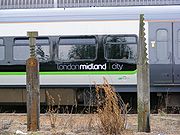
Gardening
Gardening is the practice of growing and cultivating plants. Ornamental plants are normally grown for their flowers, foliage, or overall appearance; useful plants are grown for consumption , for their dyes, or for medicinal or cosmetic use...
and landscaping
Landscaping
Landscaping refers to any activity that modifies the visible features of an area of land, including:# living elements, such as flora or fauna; or what is commonly referred to as gardening, the art and craft of growing plants with a goal of creating a beautiful environment within the landscape.#...
, both in creating retaining wall
Retaining wall
Retaining walls are built in order to hold back earth which would otherwise move downwards. Their purpose is to stabilize slopes and provide useful areas at different elevations, e.g...
s and raised-bed gardens, and sometimes for building steps as well. Traditionally, the ties sold for this purpose are decommissioned ties taken from rail lines when replaced with new ties, and their lifespan is often limited due to rot. Some entrepreneurs sell new ties. Due to the presence of wood preservative
Preservative
A preservative is a naturally occurring or synthetically produced substance that is added to products such as foods, pharmaceuticals, paints, biological samples, wood, etc. to prevent decomposition by microbial growth or by undesirable chemical changes....
s such as coal tar
Coal tar
Coal tar is a brown or black liquid of extremely high viscosity, which smells of naphthalene and aromatic hydrocarbons. Coal tar is among the by-products when coal iscarbonized to make coke or gasified to make coal gas...
, creosote
Creosote
Creosote is the portion of chemical products obtained by the distillation of a tar that remains heavier than water, notably useful for its anti-septic and preservative properties...
or salt
Salt
In chemistry, salts are ionic compounds that result from the neutralization reaction of an acid and a base. They are composed of cations and anions so that the product is electrically neutral...
s of heavy metals
Heavy metals
A heavy metal is a member of a loosely-defined subset of elements that exhibit metallic properties. It mainly includes the transition metals, some metalloids, lanthanides, and actinides. Many different definitions have been proposed—some based on density, some on atomic number or atomic weight,...
, railroad ties introduce an extra element of soil
Soil
Soil is a natural body consisting of layers of mineral constituents of variable thicknesses, which differ from the parent materials in their morphological, physical, chemical, and mineralogical characteristics...
pollution
Pollution
Pollution is the introduction of contaminants into a natural environment that causes instability, disorder, harm or discomfort to the ecosystem i.e. physical systems or living organisms. Pollution can take the form of chemical substances or energy, such as noise, heat or light...
into gardens and are avoided by many property
Property
Property is any physical or intangible entity that is owned by a person or jointly by a group of people or a legal entity like a corporation...
owners. In the UK, new oak
Oak
An oak is a tree or shrub in the genus Quercus , of which about 600 species exist. "Oak" may also appear in the names of species in related genera, notably Lithocarpus...
beams of the same size as standard railroad ties, but not treated with dangerous chemicals, are now available specifically for garden construction. They are about twice the price of the recycled product. In some places, railroad ties have been used in the construction of homes, particularly among those with lower incomes, especially near railroad tracks, including railroad employees. They are also used as cribbing for docks
Dock (maritime)
A dock is a human-made structure or group of structures involved in the handling of boats or ships, usually on or close to a shore.However, the exact meaning varies among different variants of the English language...
and boathouses.
The Spanish artist Agustín Ibarrola
Agustín Ibarrola
Agustín Ibarrola is a Spanish Basque painter and sculptor.He was born in Basauri , Spain.In 1948, the Delegation of Biscay and the city council of Bilbao granted him a scholarship to study in Madrid, where he lived until 1955....
has used recycled ties from RENFE
RENFE
Renfe Operadora is the state-owned company which operates freight and passenger trains on the 1668-mm "Iberian gauge" and 1435-mm "European gauge" networks of the Spanish national railway infrastructure company ADIF .- History :The name RENFE is derived from that of the former Spanish National...
in several projects.
In Germany, use of wooden railroad ties as building material (namely in gardens, houses and in all places where regular contact to human skin would be likely, in all areas frequented by children and in all areas associated with the production or handling of food in any way) has been prohibited by law since 1991 because they pose a significant risk to health and environment. From 1991 to 2002, this was regulated by the Teerölverordnung (Carbolineum
Carbolineum
Carbolineum is an oily, water-insoluble, flammable, dark brown mixture from coal tar components, smelling of tar. It contains among other things anthracene and phenol....
By-law), and since 2002 has been regulated by the Chemikalien-Verbotsverordnung (Chemicals Prohibition By-law), §1 and Annex, Parts 10 and 17.
Ballastless track
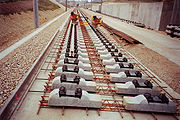
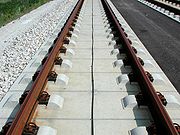
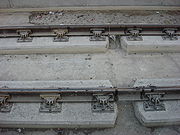
Pilatus Railway
The Pilatus Railway or Pilatusbahn is a mountain railway in Switzerland and is the steepest rack railway in the world, with a maximum gradient of 48%. The line runs from Alpnachstad, on Lake Lucerne, to a terminus near the summit of Mount Pilatus at an altitude of...
railway, built in 1889) with rails attached directly to the mountain rock. From the late 1960s onwards, German, British, Swiss and Japanese railroads experimented with alternatives to the traditional railway tie in search of solutions with higher accuracy and longevity, and lowered maintenance costs.
This gave rise to the ballastless railway track, especially in tunnels, high-speed rail lines and on lines with high train frequency, which have high stress imposed on trackage. Paved concrete track has the rail fastened directly to a concrete
Concrete
Concrete is a composite construction material, composed of cement and other cementitious materials such as fly ash and slag cement, aggregate , water and chemical admixtures.The word concrete comes from the Latin word...
slab, about half a meter thick, without ties. A similar but less expensive alternative is to accurately position concrete ties and then pour a concrete slab
Concrete slab
A concrete slab is a common structural element of modern buildings. Horizontal slabs of steel reinforced concrete, typically between 10 and 50 centimeters thick, are most often used to construct floors and ceilings, while thinner slabs are also used for exterior paving.In many domestic and...
between and around them; this method is called "cast-in precast sleeper track".
These systems offer the advantage of superior stability and almost complete absence of deformation. Ballastless track systems incur significantly lower maintenance costs compared to ballasted track. Due to the absence of any ballast, damage by flying ballast is eliminated, something that occurs at speeds in excess of 250 km/h (150 mph). It is also useful for existing railroad tunnels; as slab track is of shallower construction than ballasted track, it may provide the extra overhead clearances necessary for converting a line to overhead electrification
Overhead lines
Overhead lines or overhead wires are used to transmit electrical energy to trams, trolleybuses or trains at a distance from the energy supply point...
, or for the passage of larger trains.
Building a slab track is more expensive than building traditional ballasted track, which has slowed its introduction outside of high-speed rail
High-speed rail
High-speed rail is a type of passenger rail transport that operates significantly faster than the normal speed of rail traffic. Specific definitions by the European Union include for upgraded track and or faster for new track, whilst in the United States, the U.S...
lines. These layouts are not easy to modify after they are installed, and the curing time of the concrete makes it difficult to convert an existing, busy railway line to a ballastless setup.
Slab track can also be significantly louder
Noise pollution
Noise pollution is excessive, displeasing human, animal or machine-created environmental noise that disrupts the activity or balance of human or animal life...
and cause more vibration
Vibration
Vibration refers to mechanical oscillations about an equilibrium point. The oscillations may be periodic such as the motion of a pendulum or random such as the movement of a tire on a gravel road.Vibration is occasionally "desirable"...
than traditional ballasted track. While this is in some part attributable to slab track's decreased sound absorption qualities, a more significant factor is that slab track typically uses softer rail fasteners to provide vertical compliance similar to ballasted track; these can lead to more noise, as they permit the rail to vibrate
Vibration
Vibration refers to mechanical oscillations about an equilibrium point. The oscillations may be periodic such as the motion of a pendulum or random such as the movement of a tire on a gravel road.Vibration is occasionally "desirable"...
over a greater length.
Where it is critical to reduce noise and vibration, the concrete slab can be supported upon soft resilient bearings. This configuration, called "floating slab track", is expensive and requires more depth or height, but can reduce noise and vibration by around 80%. Alternatively, the rail can be supported along its length by an elastic material; when combined with a smaller rail section, this can provide a significant noise reduction over traditional ballasted track.
External links
- Die Y-Stahlschwelle in der Schweiz Y sleepers in Switzerland - rack and normal railways.

